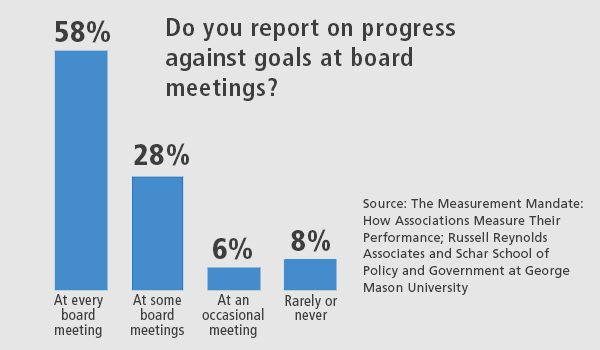How are we doing? Survey looks at how groups use metrics
How are we doing? Survey looks at how groups use metrics
- January 18, 2019 |
-
 CEO Update
CEO Update

Most associations attempt to gauge their own performance, but vary in what they measure and how often board members get updates
Jan. 18, 2019
By Martin Berman-Gorvine
Key performance indicators and executive pay-for-performance are watchwords in the corporate world, and increasingly that's true of associations as well, a survey found.
"Boards and the broader membership are asking what's the return on investment to justify paying dues and getting involved," said Stephanie Tomasso, who leads the trade and professional associations practice at Russell Reynolds Associates. The executive search and consulting firm partnered with George Mason University's Schar School of Policy and Government on the research.
In addition, "there's a big shift in the incentive structure as more boards want CEO compensation tied to performance," Tomasso told CEO Update.
The survey results are based on responses of CEOs at more than 150 associations. Overall, 87 percent of the groups surveyed had a multi-year strategic plan, 84 percent had a formal employee review process, 86 percent had qualitative goals and 83 percent had quantitative goals. All of the groups with $20 million or more in annual revenue—about 20 percent of those in the survey—had multi-year strategic plans and did formal employee reviews.
The larger organizations were also likelier than organizations below $20 million in annual revenue to set specific performance management goals and measure results for government relations (86 percent vs. 65 percent) and financial partnerships (53 percent vs. 40 percent). The smaller-revenue groups were likelier than their bigger counterparts to evaluate how they stood on total membership numbers (79 percent vs. 48 percent) and the success of fly-ins to Washington, D.C. (43 percent vs. 33 percent).
The survey didn't gather specific data on how the groups measured the success of their fly-ins, according to Tomasso, who was one of the survey report's authors.
Staying in step with the board
More startling to Tomasso was that not all the CEOs discussed their groups' performance measurements with their boards of directors at every board meeting, even though 91 percent of respondents said their boards preside over the creation of, or at least give their approval to, the association's annual goals.
"There's a real need to keep the board tied into the organizational metrics along the way," she said. "It's a surprising number that 42 percent are not reporting to the board at every meeting. There can be a perception that we (the board) haven't been informed about what the organization is working on, its goals."
CEOs of trade associations need to be especially alert to the fact that the nature of their work can be hard for board members with corporate backgrounds to understand, the report states: "The unique nature of association work, particularly as it relates to exerting influence and shaping policy or educating members, is often intangible and does not lend itself easily to short-term quantitative metrics."
Board members who don't get this "may need help understanding how nonprofit governance differs, and best practices for measuring and managing for non-financial results," the report adds.
Tomasso said organizational goals need to be "reviewed, changed or tweaked" at least annually, so that the goals and the measurement criteria stay in harmony with the group's overall mission. Such a focus can help with "communications and expectations management" with members who may want the organization to pursue impractical projects. This can lead staff into a game of "whack-a-mole" that detracts from real goals if they give in to such pressure, she said. Limiting the long-term goals to a list of four to seven helps, she said.
Other best practices tips in the report:
- Draw on the expertise of corporate executives who are on the board when designing or improving performance measurement systems.
- Use both qualitative and quantitative measures to track progress.
- Provide boards with objective data for strategic decision-making.
- Make the strategic plan "the focal point of every meeting agenda" between CEOs and the board, helping guide the board to provide meaningful input while not "getting drawn into tactical and operational issues."

